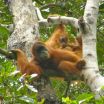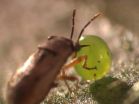(Press-News.org) Sumatran orangutans have undergone a substantial recent population decline, according to a new genetic study, but the same research revealed the existence of critical corridors for dispersal migrations that, if protected, can help maintain genetic diversity and aid in the species' conservation.
One of two species of orangutans, the Sumatran orangutan is classified as "critically endangered" by the IUCN Red List. Once widespread on the island of Sumatra, only an estimated 6,600 individuals remain, restricted to small forest patches on the northern tip of the island. Recent large-scale deforestation is among the most significant factors bringing about the range collapse of the apes.
A recent study published via Advance Access (DOI: 10.1093/jhered/ess065) in the Journal of Heredity investigated population structure, movement patterns, and reproductive interchange in Sumatran orangutans using genetic techniques. The investigators isolated DNA from fecal and hair samples from wild apes throughout their Sumatran range, as well as blood samples from orangutans of known origin that had been kept privately as pets before being confiscated by authorities. The investigators used two different genetic markers to examine population structure and gene flow: mitochondrial DNA, which is inherited only from an individual's mother, and autosomal microsatellites, short, repeated DNA elements that are inherited from both parents.
A strong genetic signal revealed a striking population decline in Sumatran orangutans. "The orangutans from one of the study areas on the west coast of the island exhibited very high genetic diversity," explained Dr. Alexander Nater of the University of Zurich Anthropological Institute & Museum, lead author on the study. "This diversity is a clear indication of a large historical population size. However this area currently harbors only around 400 orangutans," leading the authors to conclude that the population has recently declined dramatically.
The data also showed that Sumatran orangutans have a pronounced population structure containing a number of subpopulations, resulting from geographical barriers including major rivers and a large volcanic caldera. These barriers isolate groups of orangutans, some of which contain only a few hundred individuals.
"Such isolated, small populations will inevitably suffer from a decline in genetic diversity and negative effects of inbreeding," said Nater. "This means that local orangutan populations are at substantial risk of extinction."
Extinction risk can be further exacerbated when the subpopulations adapt to specific local environmental factors such as food sources or disease. While these local adaptations may allow the subpopulation to thrive in the short run, if environmental conditions change quickly the group may be unable to adapt.
Despite the isolation of the subpopulations, the authors found genetic evidence for recent reproductive interchange, specifically by breeding males. "Our study revealed that some males can range widely over large distances and across natural barriers in search of females," Nater said.
The data pinpointed a specific inland high-elevation area as an important corridor for reproductive interchange across the island. The males appear to be using this passage to circumvent major rivers close to their headwaters high in the mountains, providing important genetic exchange among Sumatran populations.
But it is critical that these corridors remain forested to facilitate these migrations. Sumatran orangutans are the most arboreal of the great apes, spending nearly all of their time in the forest canopy.
"This result highlights the need to conserve these important dispersal corridors to uphold genetic exchange," Nater said, "and it also gives hope that it is not yet too late to preserve these unique Asian great apes."
INFORMATION:
About the American Genetic Association and Journal of Heredity:
The American Genetic Association disseminates achievements in genetics through Journal of Heredity. The Journal, in print for over 100 years, covers organismal genetics across a wide range of disciplines and taxa. Articles include such rapidly advancing fields as conservation genetics of endangered species, population structure and phylogeography, molecular evolution and speciation, molecular genetics of disease resistance in plants and animals, genetic biodiversity and relevant computer programs.
Great apes, small numbers
Genetic study reveals recent decline in endangered orangutan population, but offers hope for the future
2012-10-16
ELSE PRESS RELEASES FROM THIS DATE:
Novel insights into the physical basis of sickle cell disease could lead to better treatments
2012-10-16
Sickle cell disease—the most common inherited blood disorder in the United States—causes red blood cells to distort into a crescent shape and block small blood vessels. New insights into how these abnormal cells disrupt circulation could lead to more effective treatment strategies, as revealed by a study published by Cell Press in the October 17th issue of Biophysical Journal.
"Sickle cell disease entails a central mechanical component, since the circulation gets blocked," explains senior study author Frank Ferrone of Drexel University. "We now finally understand how ...
Prion protein hints at role in aiding learning and memory
2012-10-16
Scientists from the University of Leeds have found that the protein called prion helps our brains to absorb zinc, which is believed to be crucial to our ability to learn and the wellbeing of our memory.
The findings published today (Tuesday 16 October) in Nature Communications show that prion protein regulates the amount of zinc in the brain by helping cells absorb it through channels in the cell surface. It is already known that high levels of zinc between brain cells are linked with diseases such as Alzheimer's and Parkinson's.
Professor Nigel Hooper from the University's ...
Boreal forest bends to development but there is a breaking point
2012-10-16
(Edmonton) Northern Alberta's boreal forest shows a surprising resiliency to human intrusion, but University of Alberta researchers warn the landscape has a definite breaking point.
The U of A research team led by graduate student Stephen Mayor found that up to a certain point plant life in the boreal forest responded to intrusions such as roadways and farm fields by actually increasing its biodiversity.
The researchers, counted plant species in sites across the whole of northern Alberta, an area larger than Germany. Then satellite and aerial photos were used to ...
Study advances understanding of volcanic eruptions
2012-10-16
Volcanic eruptions vary from common, small eruptions that have little impact on humans and the environment to rare, large-to-gigantic eruptions so massive they can threaten civilizations.
While scientists don't yet fully understand the mechanisms that control whether an eruption is large or small, they do know that eruptions are driven by the rapid expansion of bubbles formed from water and other volatile substances trapped in molten rock as it rises beneath a volcano. The mechanism is much the same as that involved in shaking a bottle of a carbonated drink and then ...
2-gene test predicts which patients with heart failure respond best to beta-blocker drug
2012-10-16
Tampa, FL (Oct. 16, 2012) -- A landmark paper identifying genetic signatures that predict which patients will respond to a life-saving drug for treating congestive heart failure has been published by a research team co-led by Stephen B. Liggett, MD, of the University of South Florida.
The study, drawing upon a randomized placebo-controlled trial for the beta blocker bucindolol, apprears this month in the online international journal PLoS ONE. In addition to Dr. Liggett, whose laboratory discovered and characterized the two genetic variations, Christopher O'Connor, ...
Green leaf volatiles increase plant fitness via biocontrol
2012-10-16
This press release is available in German.
To solve the acute, global problem of securing food resources for a continuously growing population, we must work constantly to increase the sustainability and effectiveness of modern agricultural techniques. These efforts depend on new insights from plant ecology, particularly from work on native plants that grow in the primordial agricultural niche. Based on field studies on wild tobacco plants in the Great Basin Desert, Utah, USA, researchers of the Max Planck Institute for Chemical Ecology in Jena, Germany, demonstrated that ...
An extremely brief reversal of the geomagnetic field, climate variability and a super volcano
2012-10-16
An extremely brief reversal of the geomagnetic field, climate variability and a super volcano
41,000 years ago, a complete and rapid reversal of the geomagnetic field occured. Magnetic studies of the GFZ German Research Centre for Geosciences on sediment cores from the Black Sea show that during this period, during the last ice age, a compass at the Black Sea would have pointed to the south instead of north. Moreover, data obtained by the research team formed around GFZ researchers Dr. Norbert Nowaczyk and Prof. Helge Arz, together with additional data from other studies ...
Link between creativity and mental illness confirmed
2012-10-16
People in creative professions are treated more often for mental illness than the general population, there being a particularly salient connection between writing and schizophrenia. This according to researchers at Karolinska Institutet in Sweden, whose large-scale registry study is the most comprehensive ever in its field.
Last year, the team showed that artists and scientists were more common amongst families where bipolar disorder and schizophrenia is present, compared to the population at large. They subsequently expanded their study to many more psychiatric diagnoses ...
Non-coding antisense RNA can be used to stimulate protein production
2012-10-16
While studying Parkinson's disease, an international research group made a discovery which can improve industrial protein synthesis for therapeutic use. They managed to understand a novel function of non-protein coding RNA: the protein synthesis activity of coding genes can be enhanced by the activity of the non-coding one called "antisense."
To synthesize proteins, the DNA needs RNA molecules serving as short "transcriptions" of the genetic information. The set of all these RNA molecules is called "transcriptome." In the human transcriptome, along with around 25 thousand ...
Genetic protection against arsenic
2012-10-16
Evolution has not only controlled human development over millions of years, it also has an impact on modern man. This is one of the conclusions of a study of Argentinian villagers in the Andes, where the water contains high levels of arsenic. A gene variant that produces efficient and less toxic metabolism of arsenic in the body was much more common among the villagers than among other indigenous groups in South or Central America. The study was a collaborative effort by Karin Broberg from Lund University and Carina Schlebusch and Mattias Jakobsson from Uppsala University ...
LAST 30 PRESS RELEASES:
Making lighter work of calculating fluid and heat flow
Normalizing blood sugar can halve heart attack risk
Lowering blood sugar cuts heart attack risk in people with prediabetes
Study links genetic variants to risk of blinding eye disease in premature infants
Non-opioid ‘pain sponge’ therapy halts cartilage degeneration and relieves chronic pain
AI can pick up cultural values by mimicking how kids learn
China’s ecological redlines offer fast track to 30 x 30 global conservation goal
Invisible indoor threats: emerging household contaminants and their growing risks to human health
Adding antibody treatment to chemo boosts outcomes for children with rare cancer
Germline pathogenic variants among women without a history of breast cancer
Tanning beds triple melanoma risk, potentially causing broad DNA damage
Unique bond identified as key to viral infection speed
Indoor tanning makes youthful skin much older on a genetic level
Mouse model sheds new light on the causes and potential solutions to human GI problems linked to muscular dystrophy
The Journal of Nuclear Medicine ahead-of-print tip sheet: December 12, 2025
Smarter tools for peering into the microscopic world
Applications open for funding to conduct research in the Kinsey Institute archives
Global measure underestimates the severity of food insecurity
Child survivors of critical illness are missing out on timely follow up care
Risk-based vs annual breast cancer screening / the WISDOM randomized clinical trial
University of Toronto launches Electric Vehicle Innovation Ontario to accelerate advanced EV technologies and build Canada’s innovation advantage
Early relapse predicts poor outcomes in aggressive blood cancer
American College of Lifestyle Medicine applauds two CMS models aligned with lifestyle medicine practice and reimbursement
Clinical trial finds cannabis use not a barrier to quitting nicotine vaping
Supplemental nutrition assistance program policies and food insecurity
Switching immune cells to “night mode” could limit damage after a heart attack, study suggests
URI-based Global RIghts Project report spotlights continued troubling trends in worldwide inhumane treatment
Neutrophils are less aggressive at night, explaining why nighttime heart attacks cause less damage than daytime events
Menopausal hormone therapy may not pose breast cancer risk for women with BRCA mutations
Mobile health tool may improve quality of life for adolescent and young adult breast cancer survivors
[Press-News.org] Great apes, small numbersGenetic study reveals recent decline in endangered orangutan population, but offers hope for the future



